Scottish Health Survey 2014 - volume 1: main report
Presents results for the Scottish Health Survey 2014, providing information on the health and factors relating to health of people living in Scotland.
This document is part of a collection
6 Obesity
Nevena Ilic
SUMMARY
Adult obesity
- In 2014, 65% of adults aged 16 and over were overweight, including 28% who were obese.
- The mean body mass index (BMI) for all adults was 27.6 kg/m2, with a similar level for men (27.5) as for women (27.6).
- The level of obesity increased between 1995 and 2008 (from 17% to 26% of those aged 16-64) but has not changed significantly since.
- Mean BMI among those aged 16-64 rose from 25.2 kg/m2 in 1995 to 27.2 kg/m2 in 2008 and has remained relatively static since (27.4 in 2014).
- A higher proportion of men than women were overweight including obese in 2014 (69% compared with 61%), while women were more likely than men to be obese (29% compared with 26%).
- Overweight and obesity remain significantly associated with age. A majority of the population was overweight (including obese) from the 25-34 age group upwards, with levels rising to 77-78% of those aged 55-74. Around a third of people aged 45-74 (33-36%) were obese.
Child healthy weight, underweight, overweight and obesity
- In 2014, 68% of children aged 2-15 were in the healthy weight range. This was not significantly different to the figure in 2013 (70%).
- Just under a third (31%) of children in 2014 were at risk of overweight (including obesity), and 17% were at risk of obesity. Both these figures have been fairly stable in recent years.
- However, the proportion of girls at risk of overweight (including obesity) was at its highest level at 34% (compared with between 27% and 30% in previous years). Further years' data will be needed to determine whether this is the start of a trend.
- Girls were more likely to be at risk of overweight (including obesity) than boys (34% compared with 28%) in 2014, though the reverse has been the case in previous years.
- In 2014, 1% of all children were at risk of being underweight, with similar figures by sex (1% for both boys and girls) and by age (1% for those aged 2-11, 2% for those aged 12-15).
6.1 INTRODUCTION
Overweight and obesity have been defined as abnormal or excessive fat accumulation that may impair health.[1],[2] Obesity is associated with an increased risk of a number of common causes of disease and, at high levels of obesity (BMI of 35 or above), death.[3] The impact of overweight and obesity upon quality of life and health is felt across the lifecourse. During childhood, those who are overweight or obese have an increased risk of conditions such as hypertension, type 2 diabetes and asthma.[4],[5] If their weight continues to be unhealthy into adulthood, children are at an increased risk of numerous conditions associated with adult obesity, such as diabetes, cardiovascular disease, osteoarthritis and some cancers.[6],[7],[8] There is also evidence suggesting a link between overweight and obesity in midlife and dementia in old age.[9],[10],[11]
Scotland has one of the worst obesity records among OECD countries.[12] Various studies have attempted to estimate the costs to the NHS in Scotland of overweight and obesity combined, with suggested figures ranging between £363 and £600 million (the majority of these costs are incurred as a result of associated conditions such as cardiovascular disease and type 2 diabetes, rather than direct costs of treating or managing overweight and obesity).[13] The latest estimates of the total (direct and indirect) cost of overweight and obesity to Scottish society, including labour market related costs such as lost productivity, have been put at between £0.9 billion-£4.6 billion.13 The health and economic consequences of obesity mean that tackling it remains a key priority for government and public health professionals.
6.1.1 Policy Background
A number of government policies and initiatives aimed at addressing the issue of obesity are in place in Scotland. In the Prevention of Obesity Route Map, the Scottish Government and COSLA outlined their long-term commitment to tackle overweight and obesity and achieve a healthier Scotland.12 The long-term goals of the route map are to have the majority of Scotland's adult population in normal weight throughout life and to have fewer overweight or obese children in Scotland.[14] The commitment to the latter of these goals is reinforced by the inclusion of the National Indicator to 'increase the proportion of healthy weight children' in the National Performance Framework (NPF).[15]
The Scottish Health Survey (SHeS) is used to monitor progress towards the NPF indicator on healthy weight children and several of the Obesity Route Map indicators.[16] Scotland's children and young people's mental health indicators set also includes an indicator on child obesity prevalence.[17]
Eat Better Feel Better is a campaign aimed at promoting healthier eating as a simple, affordable choice for everyone in Scotland. Connecting people with local cooking classes, food co-ops and community groups that can offer support on nutrition and food, the campaign aims to have a long lasting effect on families and communities. It is supported by supermarkets and the convenience sector throughout Scotland and aims to get the healthier eating message to as many shoppers as possible.
Regular physical activity helps people maintain a healthy weight. One of the themes of Legacy 2014 programmes centres around using the opportunities presented by the Games to help people be more physically active.[18] The Physical Activity Implementation Plan is one of the many legacy programmes developed under the 'active' theme to meet this desired outcome.[19] The 10 year plan, launched in 2014, links directly to the Scottish Government's legacy ambitions for the Commonwealth Games.
6.1.2 Reporting on obesity in the Scottish Health Survey (SHeS)
The anthropometric measures presented in this chapter focus on measurements relevant to adult and child obesity. Height, weight and waist measurements have been collected during the survey interview every year since its inception in 1995.[20] SHeS is one of a small number of surveys that collects height, weight and waist measures as opposed to using self-reported measures which are known to be less accurate.[21],[22] Height and weight are used to calculate Body Mass Index (BMI), the primary measure of obesity used in the SHeS series. Both adult and child trends in BMI are examined in this chapter. Waist measurements will be reported in the 2015 Annual Report. Supplementary tables are also available on the Scottish Government SHeS website.[23]
6.1.3 Comparability with other UK statistics
Adult obesity is defined consistently in the Scottish Health Survey and the other health surveys within the UK using BMI classifications. Height and weight measurements are self-reported in the Welsh Health Survey and are therefore not directly comparable with equivalent statistics in Scotland, England and Northern Ireland, where direct measurements are taken. Sampling methodologies differ between the surveys.
A Government Statistical Service publication on the comparability of official statistics across the UK advises that adult obesity figures taken from Scottish Health Survey, Health Survey for England, Welsh Health Survey and Health Survey Northern Ireland are not comparable.[24] Of the four UK health surveys, the Scottish Health Survey and Health Survey for England are the most closely aligned.
6.2 METHODS AND DEFINITIONS
6.2.1 Methods
Full details of the protocols used for collecting height, weight and waist circumference measurements are included in Volume 2 of this report and are briefly summarised here.
Height
Height was measured using a portable stadiometer with a sliding head plate, base plate and three connecting rods marked with a metric measuring scale. Participants were asked to remove shoes. One measurement was taken, with the participant stretching to the maximum height and the head positioned in the Frankfort plane.[25] The reading was recorded to the nearest even millimetre. No measurement was taken from participants who were pregnant, aged under 2, or unsteady on their feet.
Weight
Weight was measured using Seca and Tanita electronic scales with a digital display. Participants were asked to remove shoes and any bulky clothing. A single measurement was recorded to the nearest 100g. A weight measurement was not collected from participants who were pregnant, aged under 2, or unsteady on their feet. Those who weighed more than 130 kg were asked for an estimate of their weight because the scales are inaccurate above this level. These estimated weights were included in the analysis presented in this chapter.
In the analysis of height and weight, data from those who were considered by the interviewer to have unreliable measurements, for example those who had excessive clothing on, were excluded.
6.2.2 Definitions
Body Mass Index (BMI)
Body Mass Index (BMI) is a widely accepted measure that allows for differences in weight due to height. It is defined as weight (kg)/square of height (m2). This has been used as a measure of obesity in SHeS since its inception in 1995. BMI was calculated from valid measures collected by the interviewer.
Adult BMI classification
Based on their BMI, adult participants were classified into the following groups based on the World Health Organisation (WHO) classification:[26]
| BMI (kg/m2) | Description |
|---|---|
| Less than 18.5 | Underweight |
| 18.5 to less than 25 | Normal |
| 25 to less than 30 | Overweight, excluding obese |
| 30 to less than 40 | Obese, excluding morbidly obese |
| 40+ | Morbidly obese |
In this chapter, both mean BMI and prevalence for the five categories outlined in the table above are presented for adults. Although obesity has the greatest ill-health and mortality consequences, overweight is also a major public health concern, not least because overweight people are at high risk of becoming obese. Being underweight can also have negative health consequences.
Child BMI classification
BMI is defined for children in the same way as it is for adults: weight (kg)/square of height (m2). The International Obesity Task Force concluded that BMI is a reasonable measure of adiposity in children[27] and it is the key measure of overweight and obesity for children used in the SHeS series. Waist measurements were not collected in the child interview.
Despite the relatively wide acceptance of the use of BMI as an adiposity indicator, the establishment of an agreed specific obesity and overweight classification system for children and young people remains challenging. Constant changes in body composition during growth mean that the relationship between weight-for-height and adiposity during childhood and adolescence is age-dependent, and this relationship is further complicated by both ethnicity and gender.[28]
The classification of children's BMI used in this chapter, set out below, has been derived from BMI percentiles of the UK 1990 reference curves[29],[30] (referred to as the national BMI percentiles classification); these have been used in each SHeS to date. The national BMI percentiles classification has been shown to be reasonably sensitive (i.e. not classifying obese children as non-obese) and specific (i.e. not classifying non-obese children as obese).[31],[32] SIGN recommends that these reference curves and thresholds should be used for population surveillance in Scotland.7 The 85th / 95th percentile cut-off points are commonly accepted thresholds used to analyse overweight and obesity in children. These thresholds have previously been used to describe childhood overweight and obesity prevalence trends in the UK.[33],[34],[35],[36]
| Percentile cut-off | Description |
|---|---|
| At or below 2nd percentile | At risk of underweight |
| Above 2nd percentile and below 85th percentile | Healthy weight |
| At or above 85th percentile and below 95th percentile | At risk of overweight |
| At or above 95th percentile | At risk of obesity |
SHeS uses a method developed by ISD Scotland to plot the exact ages of the children in the sample against the reference population data.[37] While children's exact age was used to calculate the BMI grouping prevalence rates (based on the interview date and the date of birth), results are presented using grouped ages based on age at last birthday.
As noted in the introduction to this chapter, one of the Scottish Government's national indicators relates to healthy weight in children, defined as neither underweight nor overweight or obese.[38] The presented data have been categorised to show the total proportions that are: healthy weight, at risk of overweight, at risk of obesity, and at risk of underweight.
Other changes, made to the presentation of child BMI data in 2012 are discussed in detail in Chapter 7 of the 2012 annual report.[39]
6.3 ADULT OVERWEIGHT AND OBESITY PREVALENCE AND MEAN BMI
6.3.1 Trends in overweight including obesity prevalence since 1995
Trends in the prevalence of overweight including obesity (BMI of 25 kg/m2 or above) are presented in Table 6.1. Trends are presented for adults aged 16-64 from 1995, and for all adults aged 16 and over from 2003. The discussion that follows concentrates on the longer trend, as the larger changes in prevalence occurred between 1995 and 2003. Patterns of change in all adults (aged 16 and over) since 2003 are very similar to patterns for those aged 16-64.
The prevalence of overweight, including obesity and morbid obesity in adults aged 16-64, rose significantly between 1995 (52%) and 2008 (63%) with little change since then (ranging between 62% and 63%); it was 63% in 2014. Figures for all adults (aged 16 and over) from 2003 onwards were around one or two percentage points higher than for adults aged 16-64 in all years for which data were available (65% in 2014).
This pattern of change was very similar for both men and women. The prevalence of overweight including obesity in adults aged 16-64 has been consistently higher in men than in women in all years since 1995. For both men and women, overweight and obesity levels rose significantly between 1995 and 2008 (from 56% to 66% of men aged 16-64 and from 47% to 60% of women), with little change since then (67% of men were overweight in 2014, as were 58% of women). Figure 6A, Table 6.1
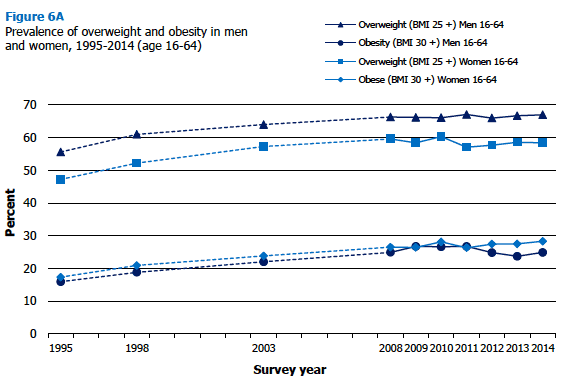
6.3.2 Trends in obesity and morbid obesity prevalence since 1995
The proportion of adults aged 16-64 who were obese or morbidly obese (BMI of 30kg/m2 or above) rose significantly between 1995 (17%) and 2008 (26%), and has remained at a similar level since (27% in 2014). Figures for all adults (aged 16 and over) were zero or one percentage point higher than for adults aged 16-64 each year (28% in 2014).
Over time, obesity trends have followed the same patterns for both men and women. Among women, obesity prevalence increased significantly among those aged 16-64 from 17% in 1995 to 27% in 2008, with little change since (28% in 2014). Among men, it rose from 16% in 1995 to 25% in 2008, and remained at the same level in 2014.
The prevalence of morbid obesity (BMI of 40kg/m2 or above) among adults aged 16-64 increased from 1% in 1995 to 3% in 2003, and has remained around that level since then (3% in 2014). Morbid obesity prevalence has been consistently higher in women aged 16-64 than men of the same age in each year since 1998. It increased significantly for both sexes since 1995, from 1% of men and 1% of women to 2% of men and 4% of women in 2014. Figure 6A, Table 6.1
6.3.3 Trends in mean adult BMI since 1995
The mean BMI for adults aged 16-64 increased significantly between 1995 (25.8 kg/m2) and 2008 (27.2 kg/ m2) and stayed at similar levels through to 2014 (27.4 kg/ m2).
A similar pattern was seen for both men and women of a rise from 1995 (26.0kg/m2 for men and 25.7kg/m2 for women) to 2008 (27.2 kg/ m2 and 27.3 kg/ m2) and then showing no notable change to 2014 (27.3kg/m2 for men and 27.4kg/m2 for women). The mean BMI has not, however, changed significantly since 2008 for either men or women. The mean BMI for all adults aged 16 and over has been 0.1 to 0.2 kg/m2 higher than that for adults aged 16-64 each year (in 2014, 27.6 kg/m2 for all adults and 27.4 kg/m2 for those aged 16-64). Table 6.1
6.3.4 Adult BMI in 2014, by age and sex
Just under two thirds of adults aged 16 and over (65%) were overweight including obese (BMI of 25 kg/m2 or above) in 2014, while over one quarter (28%) were obese (BMI of 30 kg/m2 or above). At 27.6 kg/m2, the mean BMI was higher than the recommended healthy range of 18.5 kg/m2 to less than 25 kg/m2.
Men were more likely than women to be overweight including obese (69% compared with 61%), whereas obesity prevalence was higher among women than men (29% versus 26%). In total, 2% of both men and women were underweight, while only 29% of men and 37% of women were of a healthy weight.
Mean BMI was similar for men and women in 2014 (27.5 kg/m2 for men and 27.6 kg/m2 for women).
Overweight (including obesity) prevalence was lowest among young people aged 16-24 (35%). A significantly higher proportion of those aged 25-34 were overweight (57%), with further increases with age up to age 65-74. Over three quarters of those aged 55-74 were overweight including obese (77-78%), as were 72% of those in the oldest age group (75+).
Obesity rates increased from one in eight (12%) of those in the youngest age group (aged 16-24) to around one in three (33-36%) of those aged 45-74. Again, prevalence for those aged 75 and over (28%) was slightly lower than those in middle-age groups.
Mean BMI followed a similar pattern, increasing with age from 24.4 kg/m2 for those aged 16-24, to 28.9 kg/m2 for those aged 65-74. Figures 6B, Figure 6C, Table 6.2
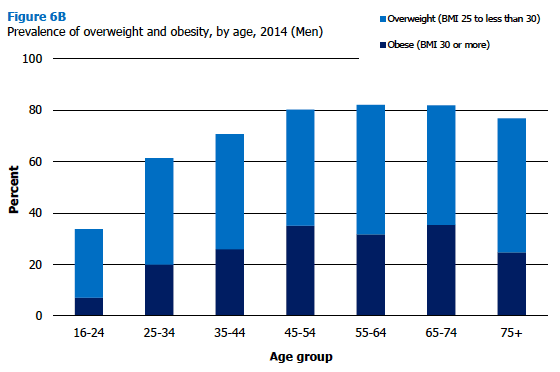
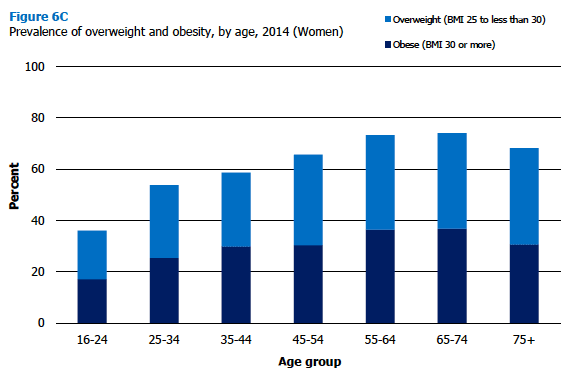
6.4 CHILD HEALTHY WEIGHT, OVERWEIGHT AND OBESITY
6.4.1 Trends in child healthy weight, overweight and obesity prevalence since 1998
A child is described as being of a healthy weight if their BMI falls above the 2nd percentile and below the 85th percentile of the UK 1990 reference curves. In 2014, 68% of children had a BMI within the healthy weight range. This figure has fluctuated around this level since 1998, and is not significantly different to the 70% seen in 2013.
Patterns of healthy weight prevalence have been more volatile for boys and girls than for all children combined. In 2014, 70% of boys were of a healthy weight, the same proportion as in 1998 and not significantly different to 2013 (67%). However, the figures for boys have seen some fluctuations, for example the figures of 61% in 2008 and 63% in 2011. Among girls, there has been slightly less variation in healthy weight prevalence over time. The 2014 level of 65% was significantly lower than that observed in 2013 (72%) and is the lowest figure recorded in any survey year. Further years' data will be needed to determine whether this is the start of a trend, rather than just random sample fluctuations.
The proportion of children at risk of overweight, including obesity (BMI at or above the 85th percentile), has also fluctuated over the years, following an inverse pattern to that seen for healthy weight. Since 1998, the proportion of children aged 2-15 at risk of overweight, including obesity, has fluctuated between 29% and 33%, and was 31% in 2014.
Trends in the proportion of children at risk of overweight, including obesity, for boys and girls also follow the inverse of the patterns discussed above for healthy weight. The proportion of boys at risk of overweight in 2014 was 28%, similar to the level in 1998 (29%), but significantly below that in 2008 (38%) and 2011 (36%). For girls, the proportion of children at risk of overweight including obesity was 34% in 2014, significantly higher than in 2013 (27%). As for the figures on healthy weight, further years' data will be needed to determine whether this is the start of a trend. Figure 6D, Table 6.3
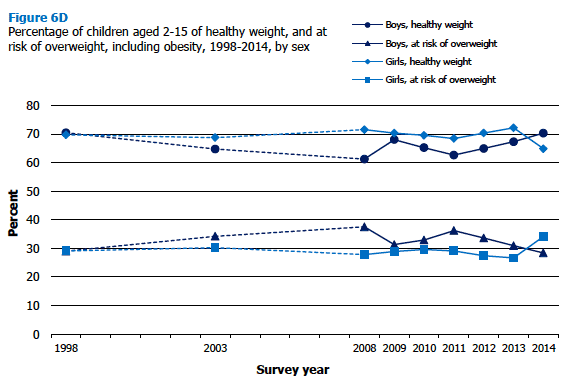
The percentage of children at risk of obesity (BMI at or above the 95th percentile) increased from 14% to 17% in the decade 1998 to 2008, and has remained around that level since 2014 (17%). In some of the previous years (e.g. 2011 and 2012), a significantly higher proportion of boys than girls were at risk of obesity. This was not true in 2014 (the figures were not significantly different). The apparent rise in both the proportion of girls at risk of obesity between 2012 and 2014, and fall in the proportion of boys at risk of obesity over the same period, was not significant and may therefore be due to sampling fluctuation. Table 6.3
6.4.2 Child BMI categories in 2014, by age and sex
In 2014, two-thirds (68%) of children aged 2-15 had a BMI within the healthy weight range, while almost one-third (31%) were at risk of being overweight or obese, and 1% were at risk of being underweight.
In 2014, 70% of boys and 65% of girls were of a healthy weight. The prevalence of healthy weight in children decreased with age, from 72% of those aged 2-6, 68% of those aged 7-11 and 61% of those aged 12‑15.
This difference by age was not statistically significant for boys (between 66% and 72% for all age groups). However, the rate of decrease with age for girls was much more evident, with 73% of those aged 2-6 in the healthy weight category falling to 63% of those aged 7-11 and 56% of those aged 12‑15.
The proportion of children at risk of overweight (including obesity) varied significantly by both sex and age in 2014, with 28% of boys and 34% of girls being overweight (including obese). In all other years since 1998, the proportion has been higher for boys than for girls, therefore this difference may be due to sampling fluctuation.
There were no differences by sex for those at risk of being underweight (1% for both boys and girls) or by age (1% for those aged 2-11, 2% for those aged 12-15).
At age 2-6, the proportion of boys at risk of overweight, including obesity, matched that for girls (both 27%). However, increases in this proportion with age were not significant for boys, but they were for girls. By age 12-15, 32% of boys and 43% of girls were at risk of overweight, including obesity.
The percentage of boys and girls at risk of obesity did not vary significantly from each other (16% and 18%, respectively), while risk of obesity increased with age among all children (from 13% at age 2-6 to 18% at age 7-11 and 21% at age 12-15), with similar patterns for boys and girls. Figure 6E, Figure 6F, Table 6.4
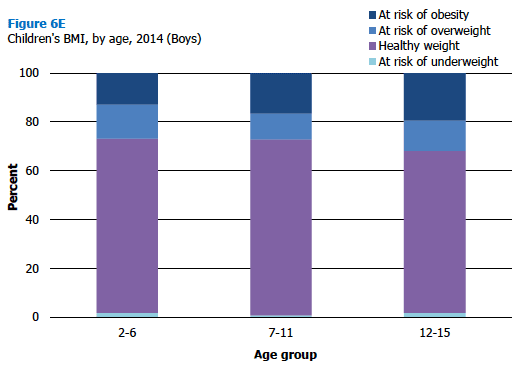
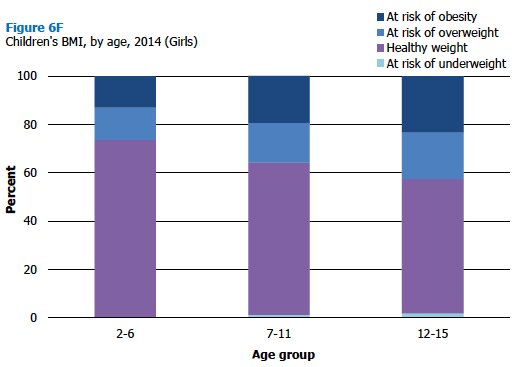
Contact
Email: Julie Landsberg
There is a problem
Thanks for your feedback